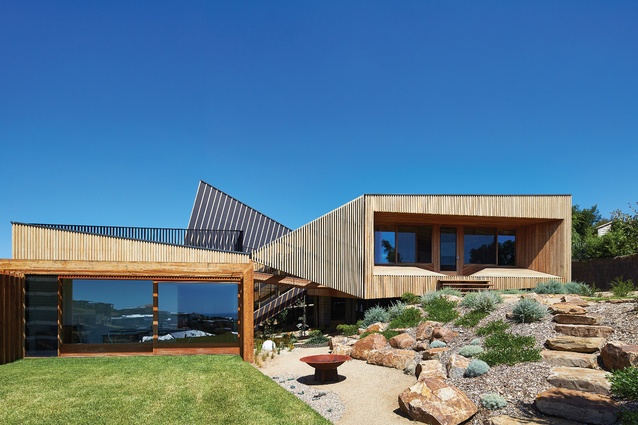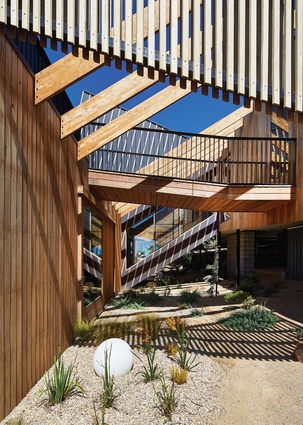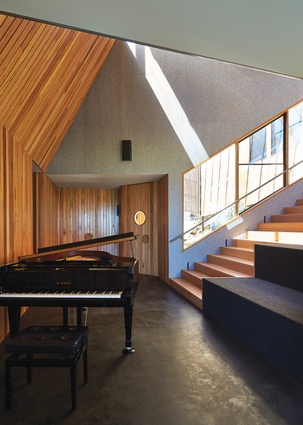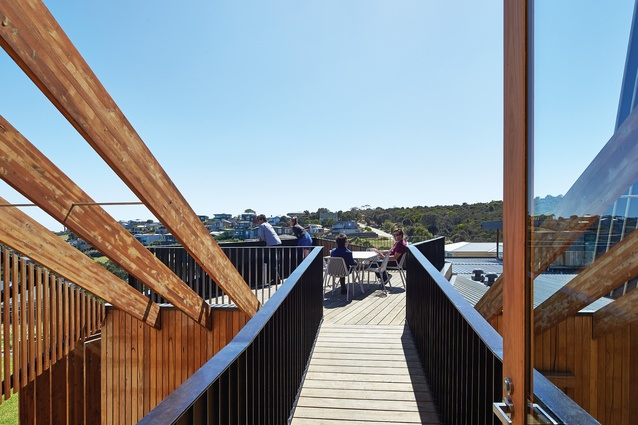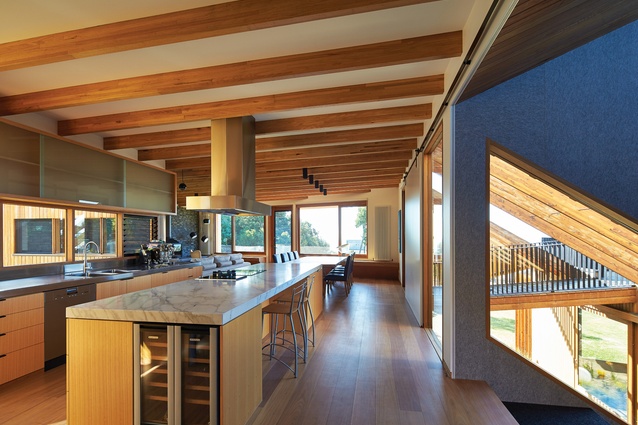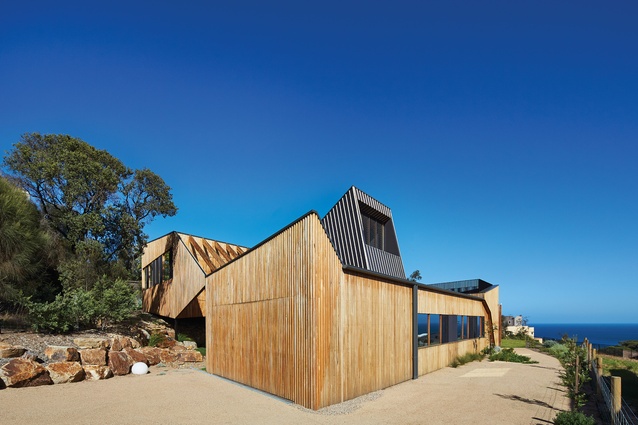Joining forces: Split House
Characterized by the experimental spirit of mid-twentieth-century design but with a firmly twenty-first-century bent, this pair of pavilions by BKK Architects provides a family home that considers privacy, thermal comfort and spatial delight.
When architects Julian Kosloff and Simon Knott invited the clients of Split House to step onto a stepladder and imagine the view from their new home on a bush block in Victoria’s Mount Martha, it probably won them the job. The directors of BKK Architects, one of three practices in the clients’ shortlist for the project, took the opportunity to share their vision that day; it involved an intimate understanding of the site’s topography, geology and vegetation. The final house design would take the slope of the land not as an obstacle, but as a means to fulfil the brief.
The clients had shortlisted the architects by analysing their responses to a detailed brief that described how they wanted to live, but, wisely, not how the design should look. The house would start as a weekender and become a fulltime residence in the clients’ retirement, and would include a space to hold grand piano performances. The site, a lot in a recent subdivision, has the quirk of a pocket of native she-oak forest at the front, creating a sense of privacy and a wider block.
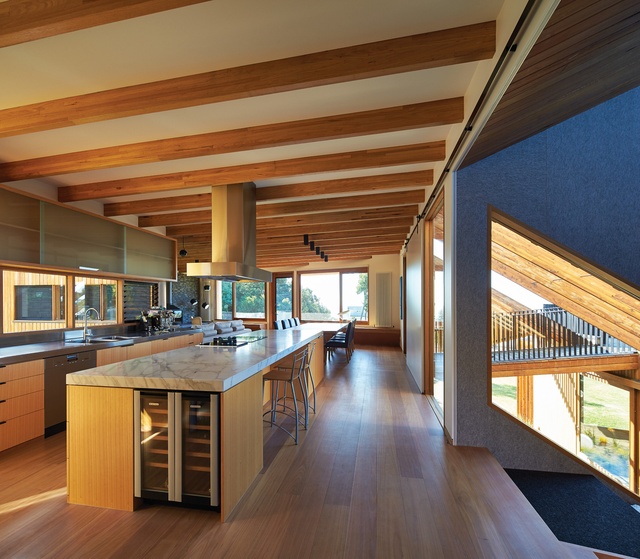
BKK Architects “split” the house into two pavilions, one for the parents and one for the children and/or guests, and stepped them down the slope. To build on a single level would have required a big cut-and-fill or floating the house on stilts; in the end the design does a bit of both, minimizing disruption to the landscape. The upper pavilion stands above its rocky terrain as a lightweight frame structure with a timber floor, and further down the slope the lower pavilion is embedded in the flatter part of the site with a concrete slab floor.
After splitting, the house is stitched back together by pergola beams, facade screens, a walkway to the roof deck and an enclosed staircase. These elements visually overlay the courtyard space, creating a sense of enclosure and a collage of layered diagonal lines. Landscaped as a dry creek bed with plants and a bubbling artificial watercourse at one end, the space draws nature into the midst of the home. In the absence of an obvious front door, visitors intuitively move toward this courtyard and discover the entry.
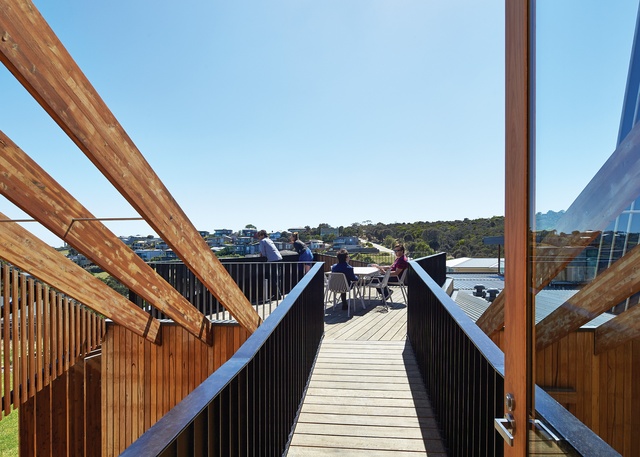
Joining the split also produces the hero – the stair. To call it a stair doesn’t encompass the myriad functions that the connecting passage performs. It is not only a bridge between the two pavilions, it’s also an amphitheatre to witness grand piano performances, a trumpet to amplify sound down the valley, a nine-metre-tall thermal chimney with operable louvres to release hot air, and an east-facing light scoop to bring morning sun to the kitchen. It also forms part of the theatre of entry, as visitors witness the clients descend the staircase to let them in.
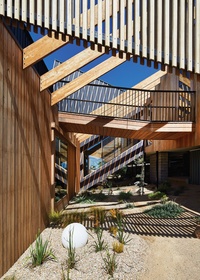
The upper pavilion contains the main living areas and the main bedroom. It lacked the thermal mass of a concrete floor, so BKK Architects designed a brick wall behind the wood fireplace in the living room to store heat and balance the air temperature, aided by hydronic radiator panels fixed to the walls. The lower pavilion is heated by electrical coils embedded in the concrete floor slab. A large sliding door upstairs provides thermal and acoustic separation when desired.
Windows offer views between spaces, through the house to the sea and to the nature reserve at the front. The house facilitates a range of activities, levels of privacy and thermal comfort. It doesn’t dictate a singular mode of occupation, “balancing the needs of a relaxed and informal beach house with the demands of permanent occupation,” as project architect George Huon puts it.
While George insists that the way the house performs programmatically was the most important driver for the design, the aesthetics of form are also dealt with in a sophisticated way. A suburban house type is increasingly the mould for new houses at Mount Martha, but for this project, the architects have eschewed typical residential typology.
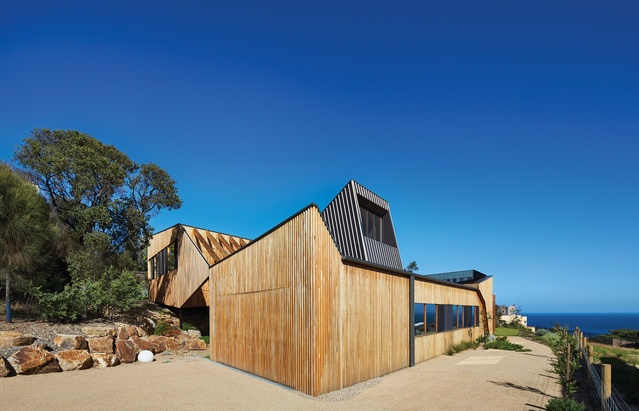
Instead, the street facade presents a series of leaning planes forming a balanced composition, without symmetry. It is an abstract form, rather than house-like. The parallelogram-shaped maximum planning envelope set by the local council has been opportunistically exploited by BKK Architects to subtly distort the geometry and create interesting spatial effects.
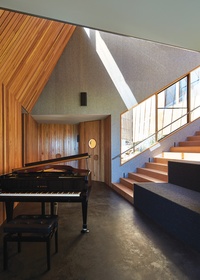
The triangular wedge that encloses the atrium/stair rises up and fuses the two wings of the house. Acute and oblique angles in the parapets disguise right angles and hide the roof. There are no dramatic cantilevers here – instead, the relatively prosaic materials and structure are cleverly manipulated to produce aesthetic effects, ranging from 2D surfaces to 3D modelling with the punched solid of the living pavilion’s garden facade.
There is an edginess to the space of the split – it has no clear program and doesn’t suggest any particular use. It is part formal landscape design, part informal undercroft storage area. George imagines that one day, grandchildren will explore its nooks and crannies. The concept of a “bi-nuclear plan,” where the parents and children are divided into separate pavilions, originated in the modernist period and was popular in the 1950s.
Split House shares the experimental spirit of the mid twentieth century, but has a firmly twenty-first-century bent, particularly with its focus on performance – architecture as infrastructure – so clearly demonstrated by the stair/atrium/bridge/concert hall. This element of drama, this intensification of use and visual (and auditory) delight, is the result of a series of pragmatic decisions. It all began with a detailed brief, an appreciation of the existing topography and a stepladder.

